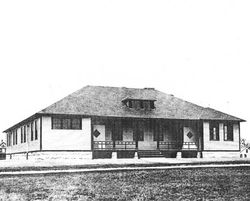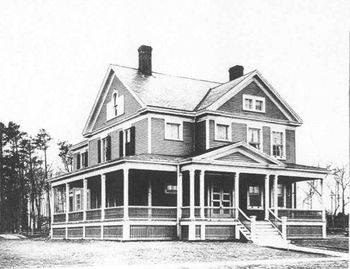Fort Rodman
| More information at Warlike, Wikipedia
Fort Rodman (1857-1867) (1898-1947) - An Endicott Period Coastal Fort first established in 1898 in Bristol County, Massachusetts on the site of previous fortifications, Fort Taber and Fort at Clark's Point. Named in G.O. 106, 23 Jul 1898, after Lieutenant Colonel William Logan Rodman, 38th Regiment Massachusetts Volunteer Infantry, who was killed in action during the U.S. Civil War at Port Hudson, Louisiana, 27 May 1863. Post declared surplus in 1947.
Third System (1857-1867)The initial purchase of land for the Fort at Clark's Point came 24 Sep 1857 by deed from Butlet H. Bixby for $78,000. Construction began soon after on a three tiered stone fort (later changed to, two casemated tiers with a Barbette tier). U.S. Civil War (1861-1865)Work on the stone fort continued through the U.S. Civil War but was not far enough along at the beginning of the war to provide protection from Confederate raiders. The city provided temporary earthworks west of the stone fort and named it Fort Taber after the city Mayor Issac C. Taber. The temporary fort was armed with cannons and a volunteer force. The earthworks remained active from 1861 to 1863 until the stone fort was complete enough to assume guard duty. The stone fort came to be known as Fort Taber after the earthworks fort was abandoned but was never formally given that name. During the U.S. Civil War construction was supervised by Captain Henry M. Robert who would become known for his "Robert's Rules of Order". Robert was eventually promoted to Brigadier General and became Chief of Engineers. Construction continued until 1867 when funding was withdrawn. The stone fort was never actually completed. Endicott Period (1890-1910)Part of the Harbor Defense of New Bedford.  Endicott Period gun battery construction began in 1898 with the two 8" batteries, Battery Walcott and Battery Barton. Both of these batteries were completed and accepted for service in 1899. The three smaller caliber batteries were all accepted for service in 1902. All five of these batteries were stand-alone structures and none were inside the old stone fort. The new Endicott Period post was designed as a compact, single company, open plan post around a rectangular parade. All of the buildings were outside the walls of the old stone fort. Four sets of officer quarters on the east side of the parade faced the single 109 man barracks on the west side of the parade. The hospital and the hospital stewards quarters were also on the west side of the parade. The administration building and NCO quarters were at the south end. Construction of the majority of the post began in 1901 and continued through 1906. By the end of 1906, all of the necessary buildings were complete.

World War I (1917-1918)Both the guns of Battery Cross were installed on the Army Transport Ship Kilpatrick sometime in 1917. This transport ship was used to transport troops from Boston to Europe. The guns were returned in 1919 but were removed for good in 1920. The guns of Battery Battery Craig and Battery Gaston were removed as a part of the 1920 disarmament program and the carriages were scrapped. By the end of 1920, only Battery Walcott and Battery Barton remained armed. In 1921 the 12" Battery Milliken was completed and accepted for service. The Fort Rodman garrison expanded during World War I with a number of temporary WWI buildings built on the southern end of the parade. The temporary buildings can be seen on the 1921 plan of the post along a diagonal road across the parade. By the 1935 plan, all of these temporary buildings have been removed and the post has been restored to its prewar state.
World War II (1941-1945)In 1940, before the start of World War II, it was recognized that virtually all of the disappearing gun batteries were obsolete and an upgrade program was begun to replace them with a more modern long-range and rapid-fire guns. Battery Milliken was selected to be upgraded by adding casemates to protect the 12" guns that were originally emplaced in open gun pits. This project was not completed until late in the war, long after the threat was over. Late in 1942, the two 8" disappearing gun batteries, Battery Barton and Battery Walcott, were deactivated and their guns were removed and carriages scrapped. Protection for the harbor moved out beyond Fort Rodman with a number of large caliber long-range guns pointed seaward and a number of smaller 6" and 90mm guns guarding the harbor approaches from dispersed locations. Fort Rodman became a training and support facility The garrison expanded significantly between 30 Jun 1940 and 30 Jun 1941, adding 15 temporary 63 man barracks and support facilities for them. The post capacity was raised from 4 officers and 109 enlisted men to 44 officers and 1054 enlisted men.
Current StatusPart of Fort Taber City Park, Bristol County, Massachusetts. The old fort is closed to the public but the batteries can be viewed and there are three original buildings still left. The PX building remains but it is moved from its original location.
Sources:
Links: Visited: 19 May 2012 | ||||||||||||||||||||||||||||||||||||||||||||||||||||||||||||||||||||||||||||||||||||||||||||||||||||||||||||||||||||||||||||||||||||||||||||||||||||||||||||||||||||


